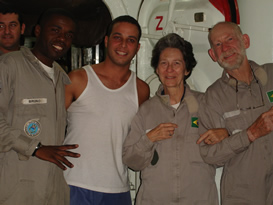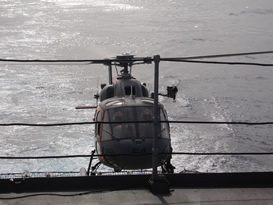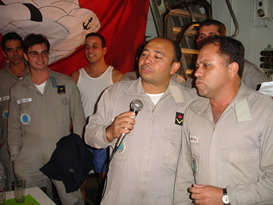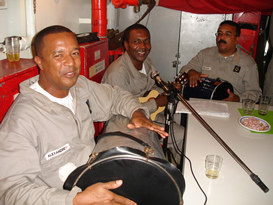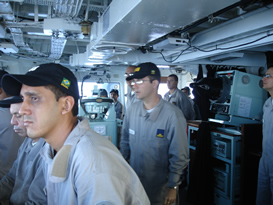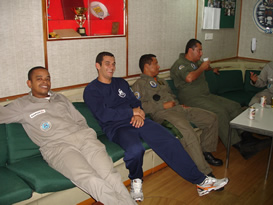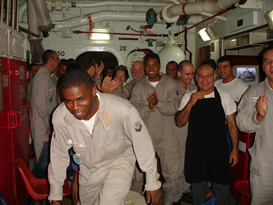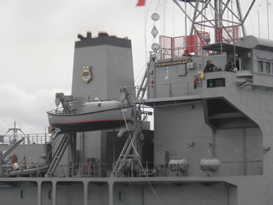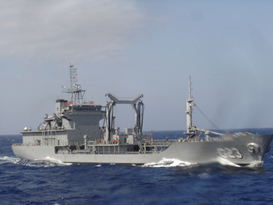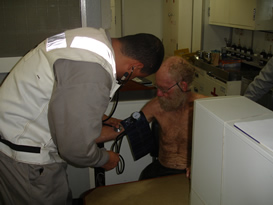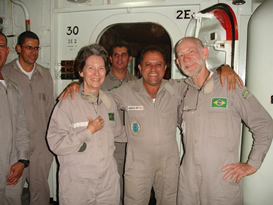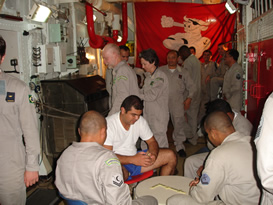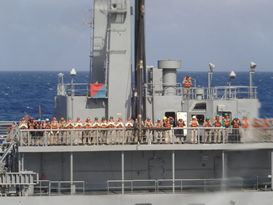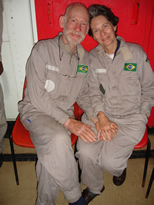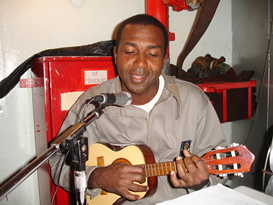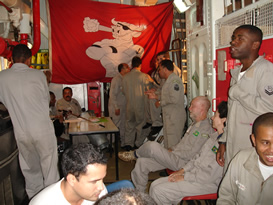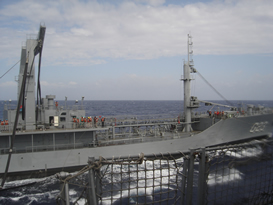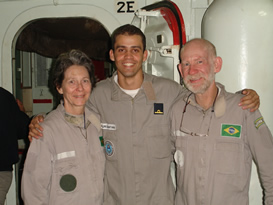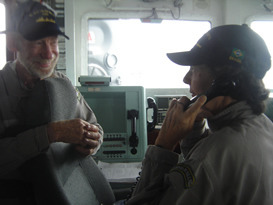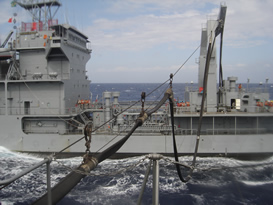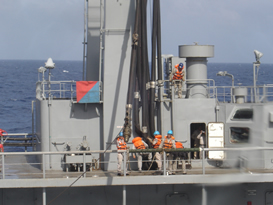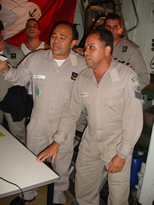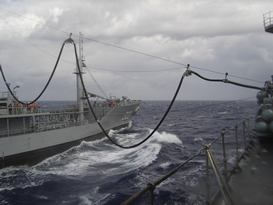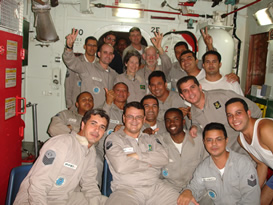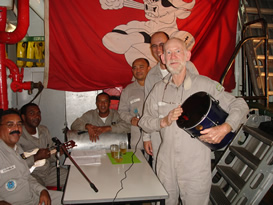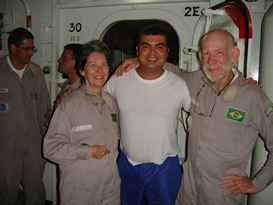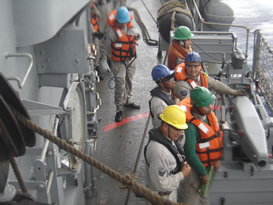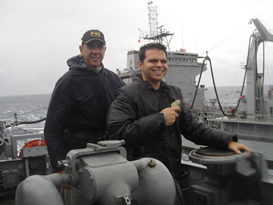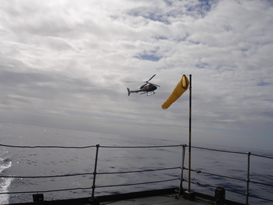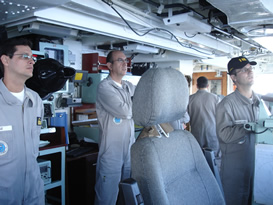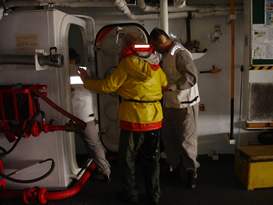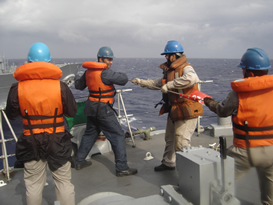The approach to the Angolan port of Lobito, a day sail north of Baia Azul, along the sandspit, which protects the harbour, seemed endless as it shimmered white in the blazing sun in a flat sea. C-Maps was a great help in finding the entrance, where there were navigation buoys! First we had seen since Walvis Bay. We motored close alongside the shore inside the entrance (as per Raymond’s advice) and although about 50m off the depth remained at 20m+. We located the yacht club – the only masts belonged to a 23ft day-sailor and a catamaran. A friendly ski-boat gave a friendly wave and said to tie up anywhere. We picked up a buoy and fell over in a heap in the humidity, just like Durban.
Lobito is a large, sheltered, natural harbour. Formed on the sea side by a large sand-spit which creates a tidal lagoon on the inland side. This sand-spit has a paved road lined with very tall trees that runs down its center with houses and buildings on either side. On the outside of the buildings are the beaches; on the sea side breakwaters give protection against the pounding waves. On the protected lagoon side, the beaches reach up to a secondary road, which allows access to the houses; those furthest from the city, towards the entrance, are bigger and grander, some are beautiful colonial-style mansions. The club is located about half way between these affluent residences and the harbour offices, located where the mainland joins the sand-spit.
Next to the club is a derelict building with no roof; looks like it may have been a theatre or cinema; lots of people living in the various rooms. When the tide is in, the sea reaches the edge of the surrounding open veranda, from where children dive into the water. When the tide is out, a little beach appears where a fishing boat may be drawn up. Close alongside was the skeleton structure of an apartment block, abandoned while still at floor and inner support wall construction stage. Lots of people living there and they have erected chicken wire between the outside columns and covered it in cardboard and sheets of material, to form outside walls. All these buildings have satellite dishes – lots of old large 3m open-mesh types (no scrap-metal market here) and the newer smaller types, plus dozens of assorted antennas. The buildings are festooned with coaxial cables, which double as clothes lines.
The big ships tie up alongside wharfs, or anchor off, about half a mile further on from us. The trawlers disappear beyond the quays, must be a smaller basin. Opposite us on the mainland is the fuel and LPG discharge depot. The tankers anchor off between buoys and load/discharge from a floating pipe terminal. Up above, on the steep hills are the abandoned buildings of a cement factory but further along a thriving suburb of mud houses.
Despite theses signs of industralization the harbour is very scenic. The edges of the shore are lined with pale sandy cliffs, whose vertical faces plunge into the sea below. Above green rolling hills fold away into the distance with few signs of human habitation. One of the few buildings is the old abandoned light-house and the road winding up to it. During the late afternoon the shadows and angle of light show up the folds of the hills and valleys dramatically. When night falls there are lights around the harbour and providing there is power, more lights appear on the sand-spit and a few more amongst the mud houses. It seems strangely quiet for a city and port; no trains, heavy truck traffic, or industry, although we are some distance away from the center. The only sounds may be generators humming and the soft sound of oars dipping on returning fishing boats. The fishermen also use huge lateen sails; the luff edge along the yard is about two-and-half times the boat-length, they are very efficient and are capable of good speeds in the lightest of airs. They all give a friendly wave as they pass by, we suspect they are quite curious about this strange craft with such small sails. It is so sheltered that ‘Dalkiri’ hardly moves on her swing mooring.
Costa having heard via radio where we were, alerted his friend Mila and we met her ashore. She phoned the Port officials and arranged for them to visit us and told Artur Fontura, the Club Director, of our arrival. Thanks to Mila’s shipping experience she soon sorted out the paperwork. The problem was that they really did not know how to treat such a small ship, used to large ships as they are; Mila told them that we were too small to tax. She kindly brought us a local pine-fruit from her garden; looks a bit like a green pine-cone, has flesh & pips similar to Victor’s sud-sud. (Have since seen it here in Rio.)
We met Artur who suggested we make a shopping list in case we had to stay onboard. He told us that the authorities were not sure how to treat us, but he pointed out we were tourists (rare and unknown creature). We have been released into his care (as a citizen of long standing). If we go into town we must go with him, he then hands our passports in to be collected on our return to the yacht.
He returned later with our passports (the officials had taken them) and we took our empty fuel containers, gas cylinders and shopping list ashore. The fuel we filled from a nearby garage, it was very cheap about SAR 0,70 p/lt! Artur organized for the gas to be filled, not as easy task as our bottles were unlike anything Lobito had seen, but as Artur knows everyone, it was arranged. When we enquired about water he took us to a shop supplying bottled water, which is what everyone uses here. (5lt bottles cost Kw270)
Then he drove us to the market in the neighbouring town of Catumbela, where most fruit and vegetables could be had. A vender offered what looked like orange wood bark, Artur told us it was quinine and that his mother used to boil and administer it as a remedy when he was a child. Catumbela is over 300 years old and was the original Portuguese settlement in the area, based on rubber plantations, later replaced by sugar. The derelict remains of a sugar-mill can still be seen, as can the factory once used for processing sun-flower oil. The somewhat neglected and mostly abandoned town is charming, with a cathedral at its center and beautiful mosaic paved pavements (black and white Portuguese style). The area between Catumbela and Lobito is a river flood plain. Originally planted with sugar, today it is divided into numerous self-subsistence plots by tall palm trees and we could see crops of paw-paws, bananas, mangoes, maize, cane and more. Alongside the road are the shells of abandoned factories and the frameworks of new constructions. The area is opening up again and bringing with it many ‘sharks’, according to Artur
We stopped in a street in Lobito at a local money-changer, where the rates are better than the bank. It seems that every street has its own representative and Artur says he always deals with the same person. Everyone here deals in US$ so currency, so its an on-going occupation.
Many of the pavement level shops are boarded up, otherwise the city seems in pretty good shape. Of course there are pot holes everywhere and neglect but it seems that the civil war did not affect this part of the country. We went to a grocery shop for cheese and eggs; the shop had most foods, was air-conditioned but the fridges were off! There are power-cuts and the supply of power is limited per day; we passed 2 restuarants, which were closed because they had no power. We found a small popular place on the beach to have a bite and Artur told us a bit about himself and Lobito. Born in Angola, Artur has spent his life in Lobito running the family business.
‘Lobito’ apparently means ‘sitting room’ and is 92 years old. The yacht club was originally the Railways Sports Club and celebrates its 90th anniversary this year. Before the civil war it must have been splendid; a marble staircase sweeps up from the ground floor to the upper level and a large painted wall mural. A wooden parquet floored hall, now used as a physical fitness studio, must have once been the main function room. Trophy cupboards line the corridors reflecting various sporting disciplines over many years. Just waiting to be dusted & polished up for the next series of events. From the upper veranda one looks down onto a now empty Olympic size swimming pool; obviously well built it has no cracks, tiles still in place and no litter – just add water, and people!
There is a restaurant in the club, but the lady who runs it was away on holiday during our stay. The ground floor, on the lagoon side has several parking areas for motor-boats and workshops. There are a surprising number of boats in storage. One wall is lined with glass fronted aquarium tanks, now empty. An overhead swinging crane/pully system, still in use, hauls the motor-boats out of the water up to the workshop level, where they are lowered onto trailers. There are always a number of locals working here, fixing, cleaning, hauling; these caretakers put the boats away, or launch them onto the water ready for the owners arrival. Most of the boats seemed to be used for fishing. Artur told us that Marlin weighing up to 350 Kg are caught about 15 mls offshore. There are photographs on the Club notice boards that testify to this. Artur has 2 motor-boats and a jet-ski, so he organizes the security at the club. There are big spot-lights shining on the water and the area is well lit (when there is power) and a security guard is always around. The last yacht to visit was 1973.
Artur’s wife & 3 sons, all at university, live in Portugal. He has a Motoguzzi 1100 which he uses for weekend tips into the interior & he hopes to ride from Angola to Mozambique in the future. During the war years it was only possible to travel by plane, now he says he can travel anywhere and at anytime, day or night, its quite safe. The roads are very bad and it does take longer to travel somewhere, but at least with a motor-cycle you can go around the pot-holes! He obviously enjoys re-discovering the surrounding areas and showed us photographs (the wonders of digital cameras) of the interior. Sweeping vistas of lush mountainous regions, with beautiful wild flowers.
It seems Lobito will be expanding in the future; previously the oil rigs came from Nigeria, but now they are being build in Angola and an oil refinery is to be built in Lobito in 2006. I do hope that in their march forward they don’t destroy the nearby wetlands. On the outskirts of town, there are saltpans where flamingoes and other birds forage. The flamingo forms part of Lobito’s crest (like Walvis Bay) & it features on their website.
Close to the Club there are several very tall pine trees and from our mooring we have a great view of a tree (about 60ft) in which several grey herons nest. There appear to be several juveniles who stand, hunched next to heaps of sticks (nests?) awaiting the return of food bearing adults. We have also seen 2 spoonbills roosting in the same tree and on another day a fish eagle spent some hours in the tree – did not seem to upset any of the other birds. Artur says there are many trees in town where herons and pelicans roost and some people consider them to be pests. The only other ‘wild life’ we saw was when the guys at the club hauled up the crayfish traps. They keep about 6 traps around the jetty pilings and inspect them every couple of days. We also saw some tiny fish (spot on blue tails?) swimming near ‘Dalkiri’. Visibility was fair and the water clean (no litter or garbage) so we copied the locals and cooled down with a swim., although its as warm as a swimming pool in Durban.
The rest of the week in Lobito was spent doing chores: stowing fuel, gas, vegetables; laundry; hunting cockroaches, which have reappeared now we are in the tropics. Jess sewed several anti-chafe patches on the foresail and put a length of anti-chafe tubing along the life-line. On the next leg, because of the prevailing Trade winds, we expect to remain on the same tack (ie. the sail will stay on one side), which may cause chafe. Also hauled out the South American Pilot and notes from forepeak, put away the South African Pilot and set about plotting waypoints and a course for St. Helena Island (finally).
Although the water is not suitable for drinking, we decided to take extra, in case of an emergency. Remembering how Rowena had cleaned her fish-tank in Walvis Bay (knew that would come in useful) we used wads of cotton-wool as a filter and were surprised at how brown they became – filtering took ages. Jess cut his hair and beard; I was trimming edges when whoops the comb came off plus a chunk of beard! Nasty remarks are still being muttered.
Artur brought fresh bread and a policeman on Saturday; the officer came aboard, looked below and that was it – no papers, no exit stamp! Artur followed us out to the harbour entrance taking photographs from his ski-boat, while we took photographs of the houses along the shore and across the bay. Near the entrance we met Mila returning from a successful mornings fishing; she came alongside and gave us 5 small fish. We had them for supper and again the next day – delicious, lovely and sweet. So we sailed in a light breeze, off into the sunset, on a calm sea. (31st Jan.)
We found the locals friendly but not forward and we never felt unsafe in Angola. There seems to be respect for buildings and property, because despite neglect, due mainly to lack of funds, materials and know-how, places have not been vandalized. Eg. We saw several buses parked on the lagoon road in Lobito and thought at first that it was a bus terminus; later we realized they never moved and had been abandoned, yet they remained intact! In SA there would have been no tyres, wheels, seats etc. There is a strange air of suspension, as if expecting the return of those who left. Perhaps it was our fanciful imagination, but that was the overall impression we were left with.
We think it’s a wonderful cruising area and we’re sure there will be many more sailors detouring through this friendly country. Others speak well of Luanda and the hinterland continues to reopen. Angola is also on a direct route across to Ascension Island and routes north and west. We regret that we did not have a proper visa, which would have allowed us to stay longer, also that we do not speak Portuguese.
It was a special experience – thanks to the many people who made it possible. We really do not know how to thank all the people who looked after us and passed us on to others who did the same. I think that we’ve become so suspicious and cynical in S Africa that we’ve forgotten the concept of hospitality and this visit has shown us another attitude.
Thank-you Angola, from Heather & Jess onboard ‘Dalkiri’
PS: As our onboard library is limited, if you can identify any wildlife mentioned, please let us know, and if our historical facts are incorrect, or if you have some more informa- tion, we would love to hear from you. Thank-you: The letters are typed on a laptop, kindly donated by Graham (ZS2ABK), otherwise there would be no news!.


